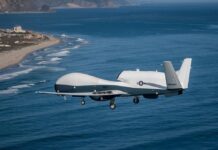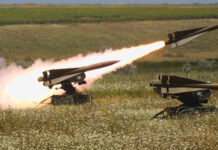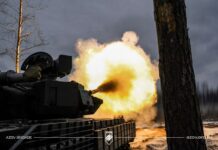Ukraine has used bomb-laden unmanned aerial vehicles (UAVs) to attack a factory in Russia’s Tatarstan region more than 1,200 km from unoccupied Ukrainian territory in what appears to be the Ukrainian military’s deepest strike of the war so far.
The factory, located in the town of Yelabuga, is believed to be a site where Shahed UAVs supplied to Russia from Iran are assembled and was attacked around 05:45 local time on 2 April 2024.
A video of the attack posted online by Russian media outlet Ostorozhno Novosti shows a bomb-laden UAV derived from a light aircraft diving onto a factory site and causing a sizeable explosion. The location has been verified by media channels such as Reuters as being in Yelabuga.
Ukraine’s military intelligence said the strike on Yelabuga “caused significant destruction of production facilities”, although this was denied by Tatarstan’s regional leader, Rustam Minnikhanov.
The UAV in question appears to be based on a two-seat A-22 Foxbat ultralight aircraft made by Ukrainian aerospace company Aeroprakt. This aircraft typically has a maximum range of 1,100 km and an endurance of 10 hours, although this officially stated range is probably based on a manned flight with an emergency reserve. It is thus conceivable that, for a one-way unmanned flight, the aircraft could reach Yelabuga from Ukraine with a sizable warhead payload in place of the pilot.
Perhaps a more interesting question is how a light aircraft with a cruising speed of just 180 km/h could penetrate so far into Russian airspace without getting shot down, especially when the country is at war.
Ukraine has been using bomb-laden UAVs to strike at Russian infrastructure for several months, with the UAVs in several cases reaching their targets. In January a major gas terminal was struck in St Petersburg, which is around 900 km north of Ukraine’s border.
A Ukrainian source who spoke to CNN following Ukrainian UAV attacks on oil refineries in recent months suggested that the Ukrainian UAVs used for those strikes are equipped with an artificial intelligence-enhanced terrain-following capability, meaning they do not need to communicate with any ground station and can autonomously make their way to their targets without being jammed.
It is possible that this capability, combined with a low-altitude flight plan, has allowed the Ukrainian UAVs to avoid being shot down, but Russia’s air defences are clearly having their own problems, even as Russia’s own UAV and missile attacks cause problems for Ukraine.
Even if the damage caused by the Yelabuga attack is not significant, it could still conceivably force the Russians to spread their air defence assets over a wider area to avert further such embarrassments.













